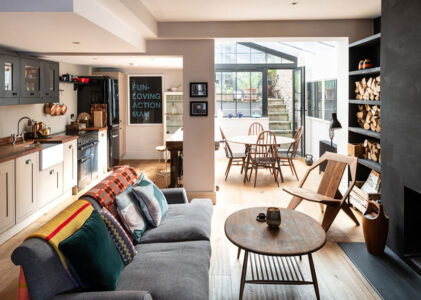Designing for small spaces requires an understanding of the limitations that come with them. It is important to consider the available space and how it can be utilized to maximize functionality. Kathryn Bechen’s book, “Small Space Organizing: A Room-by-Room Guide to Maximizing Your Space,” provides helpful tips for designing small spaces. One key aspect is to have a plan that takes into account lighting, windows, and furniture placement. By understanding these limitations, it is possible to create a functional and stylish small space.
Maximizing functionality through smart design is essential when working with small spaces. Choosing furniture and decor that serves multiple purposes is a great way to maximize space. For instance, selecting furniture pieces that are easy to move around and have dual purposes can help save space. Additionally, opting for small-scale furnishings that are neatly upholstered can help prevent overcrowding. Multi-functional furniture, such as a desk with a small bench, is another great option for maximizing space and function. By incorporating smart design features, it is possible to create a small space that is both functional and stylish.
Choosing furniture and decor that serves multiple purposes is a great way to maximize space in small homes. Multi-functional furniture is a great way to maximize small spaces. Vertical space can also be utilized to create more storage and functionality. Clever storage solutions and simple room dividers can also help make the most of a small space. By incorporating these design tricks, it is possible to create a small space that is both functional and stylish.
Creating the illusion of space
Maximizing functionality in home design is essential when it comes to small spaces. One way to create the illusion of space is through the use of color and lighting. Light colors, such as neutral shades, help to reflect light and create the illusion of a larger space. Additionally, using light and translucent materials for window treatments can maximize the flow of natural light into the room. This, combined with strategic placement of lighting fixtures, can create a bright and airy atmosphere that makes the space feel larger.
Another way to create the illusion of space is through the strategic placement of mirrors and artwork. Mirrors reflect light and can make a room appear larger than it actually is. By placing mirrors in strategic locations, such as across from windows or in narrow hallways, one can create the illusion of depth and make the space feel more open. Similarly, choosing artwork that creates a sense of depth, such as landscape paintings, can also make a small space feel larger.
When it comes to furniture selection, it’s important to choose pieces that are visually light and do not overwhelm the space. Multi-functional furniture is also a great way to maximize small spaces. For example, a sofa bed can serve as both a seating area and a guest bed, while a storage ottoman can provide additional seating and storage space. It’s also important to avoid oversize furniture, which can take up valuable floor space. By incorporating these design elements and creative storage solutions, one can create a functional and stylish small space that feels much larger than it actually is.
Organization and storage solutions
When it comes to designing a small space, organization and storage solutions are key to maximizing functionality. Creative storage ideas can help keep a small space tidy and clutter-free. One example is substituting closet space by using a garment rack or freestanding wardrobe. Additionally, shelf dividers and stackable freestanding bookshelves are great options for small spaces. Incorporating built-in storage into the design is also a stylish and functional solution. By implementing these creative storage ideas, small spaces can feel more spacious and organized, while maintaining style.
Utilizing vertical space for storage is another effective way to maximize the functionality of a small space. Vertical shelving or cabinetry can add plenty of storage space while showcasing decorative items. Wall-mounted shelves are also a great option to provide additional storage space while keeping the floor area free. By designing for vertical space, the height of the room can be utilized with shelves, cabinets, and other storage options. These storage solutions not only provide more storage space but also create a visually appealing design element in the room.
Incorporating organization and storage solutions into small space design can make a significant impact on the functionality of the space. To enhance storage in a tight space, thinking vertically is crucial. However, it is important to balance functionality with style. Natural light is also an important aspect of small space design, as it can make a space feel larger and more open. By carefully considering organization and storage solutions, small spaces can be transformed into functional and stylish living areas.

